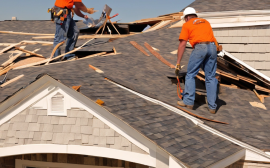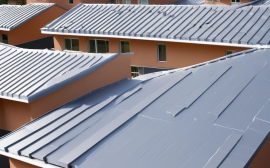Introduction: The Importance of Winter-Proofing Your Roof
As winter approaches, homeowners in colder climates must prepare their homes for the challenges ahead. Among the most critical areas to safeguard is the roof, which bears the brunt of snow, ice, and freezing temperatures. Neglecting roof maintenance can lead to costly repairs, water damage, and even structural issues. This guide provides actionable advice and practical tips to winter-proof your roof, ensuring its longevity and protecting your home from the elements. Whether you’re a seasoned homeowner or a first-time buyer, understanding the basics of winter roof maintenance is essential for peace of mind and financial security.
Think of it as an investment, not an expense. By proactively addressing potential problems, you can avoid expensive repairs and extend the life of your roof. The importance of winterizing roof systems cannot be overstated, particularly given the escalating costs associated with home repairs. Industry data reveals that water damage, often stemming from neglected roofs and inadequate ice dam prevention measures, accounts for a significant percentage of homeowner insurance claims during the winter months. According to the National Roofing Contractors Association (NRCA), preventative roof repair and consistent roof maintenance tips can extend a roof’s lifespan by several years, potentially saving homeowners thousands of dollars in replacement costs.
Engaging in regular gutter cleaning winter efforts is a simple yet effective strategy to mitigate water damage risks. A comprehensive roof inspection checklist should be a staple in every homeowner’s winter preparedness plan. Effective winter roof maintenance extends beyond mere aesthetics; it’s a crucial component of home energy efficiency. A well-maintained roof provides optimal insulation, preventing heat loss and reducing energy consumption during the coldest months. Cracks, damaged shingles, or inadequate sealing can compromise the roof’s insulating properties, leading to higher heating bills.
Addressing these issues promptly through targeted roof repair and proper winterizing roof techniques not only safeguards the structure but also contributes to significant energy savings. Furthermore, consider that the cumulative effect of many homes improving their energy efficiency can lead to broader community-wide benefits, reducing overall energy demand during peak winter periods. Beyond the financial and practical benefits, proactive winter roof maintenance offers an invaluable sense of security and peace of mind. Knowing that your roof is well-prepared to withstand the harsh winter elements allows you to focus on other aspects of home and family life without the constant worry of potential roof-related emergencies. Implementing a robust ice dam prevention strategy, coupled with regular gutter cleaning winter routines, empowers homeowners to take control of their property’s resilience. Remember that a small investment in time and effort now can prevent significant headaches and expenses later, ensuring a warm, safe, and comfortable winter season for you and your family. Consult with local roofing professionals for tailored advice and assistance to optimize your winter preparedness efforts.
Pre-Winter Roof Inspection: Identifying Potential Problems
Before the first snowflake falls, a thorough roof inspection is paramount. This involves carefully examining the roof’s surface for any signs of damage or wear. It’s best to conduct this inspection on a clear, dry day. Use binoculars to get a closer look from the ground, or, if you’re comfortable and have the proper safety equipment (sturdy ladder, safety harness), carefully ascend onto the roof. This pre-winter roof inspection is a critical step in winter roof maintenance, allowing you to identify and address potential problems before they escalate into costly repairs.
Ignoring this step can lead to significant water damage and structural issues throughout the winter months. Prioritize safety and consider hiring a professional if you are not comfortable performing the inspection yourself. Remember, preventative measures are always more cost-effective than reactive repairs. A comprehensive roof inspection checklist should include several key areas. Damaged shingles are a primary concern; look for shingles that are cracked, curled, missing, or have lost granules. Granule loss is often visible as dark patches and indicates that the shingle’s protective layer has been compromised, reducing its ability to effectively shed water.
Leaks are another critical issue. Check for water stains or discoloration on the underside of the roof decking in the attic. Also, inspect around chimneys, vents, and skylights for signs of leaks, as these areas are particularly vulnerable to water intrusion. Compromised flashing, the metal material installed around roof penetrations, should also be inspected for rust, cracks, or gaps, as damaged flashing is a common source of leaks. Gutter condition is also crucial for effective winterizing roof strategies.
Clogged or damaged gutters can cause water to back up onto the roof, leading to ice dam formation – a major cause of winter roof damage. Ensure gutters are clean and securely attached to facilitate proper drainage. As part of your roof maintenance tips, consider installing gutter guards to prevent debris buildup and reduce the frequency of gutter cleaning winter tasks. Finally, attic ventilation plays a vital role in ice dam prevention and moisture buildup.
Check that vents are clear and unobstructed to ensure proper airflow. Poor ventilation contributes to temperature imbalances that cause ice dams and can lead to condensation, fostering mold growth and wood rot. Addressing these issues proactively is a key element of responsible home improvement. Addressing minor roof repair needs discovered during the inspection is essential before winter arrives. Small cracks in flashing can be sealed with roofing caulk, and loose shingles can be reattached. For more extensive damage, consulting a professional roofing contractor is advisable. Prompt attention to these issues prevents water from penetrating the roof structure, freezing, and expanding, which can cause significant damage. This proactive approach not only saves money in the long run but also ensures the structural integrity of your home during the harsh winter months. Implementing these roof maintenance tips will significantly reduce the risk of costly repairs and ensure a safe and comfortable winter season.
Essential Cleaning Tasks: Removing Debris and Preventing Moisture
Cleaning your roof is an essential aspect of winter roof maintenance. Neglecting this task allows debris, moss, and leaves to trap moisture against the roofing material, accelerating deterioration and significantly increasing the risk of ice dam formation. Use a leaf blower, working from the peak downwards, or a soft-bristled brush to gently remove loose debris from the roof’s surface and gutters. Prioritize safety above all else; if you’re uncomfortable on a ladder or the roof itself, consider hiring a professional.
The small investment in professional gutter cleaning winter preparation can prevent costly roof repair down the line. Essential cleaning tasks should address three key areas. First, remove all loose debris, including leaves, branches, and other organic material from both the roof surface and gutters. Accumulated debris acts like a sponge, holding moisture and creating ideal conditions for ice dams. Second, tackle moss and algae growth. These organisms retain moisture, degrade shingle surfaces, and can even work their way under roofing materials.
Apply a specialized roof cleaner designed to kill moss and algae without harming your specific type of roofing. Always avoid harsh chemicals or pressure washers, as these can cause irreparable damage. Finally, ensure thorough gutter cleaning to guarantee proper water drainage away from the roof and foundation. Clogged gutters force water to back up, leading to ice dams, leaks into the home, and potential structural damage. Incorporating a roof inspection checklist as part of this process will help identify any underlying issues.
The cost-benefit analysis of DIY versus professional cleaning requires careful consideration. While DIY cleaning can save money upfront, professional services often include a more comprehensive roof inspection and cleaning, potentially identifying hidden problems a homeowner might miss. These professionals are also trained in safety protocols and equipped with the necessary tools to work efficiently and effectively. According to the National Roofing Contractors Association, preventative winterizing roof maintenance, including professional cleaning, can extend the lifespan of a roof by several years. Consider the value of your time, your comfort level with heights, the potential risks involved, and the long-term benefits before deciding whether to DIY or hire a professional. Ultimately, investing in proper winter roof maintenance is an investment in the overall health and longevity of your home.
Preventative Maintenance: Gutter Cleaning and Ice Dam Prevention
Preventative maintenance is key to minimizing winter roof damage. This includes cleaning gutters, preventing ice dams, and addressing minor repairs promptly. **Preventative Maintenance Steps:** * **Gutter Cleaning:** As mentioned earlier, clean gutters are crucial. Consider installing gutter guards to prevent debris buildup.
* **Ice Dam Prevention:** Ice dams form when melting snow refreezes at the edge of the roof, creating a dam that prevents water from draining properly. This can lead to water backing up under the shingles and into the house.
Strategies for preventing ice dams include:
* **Improving Attic Insulation:** Proper insulation helps to maintain a consistent temperature in the attic, reducing snow melt.
* **Sealing Air Leaks:** Sealing air leaks in the attic prevents warm air from escaping and melting snow on the roof.
* **Installing Heat Cables:** Heat cables can be installed along the roof’s edge to melt snow and ice, creating a channel for water to drain. These are particularly useful in areas prone to ice dam formation.
* **Applying Ice Melt:** Ice melt products can be applied to the roof’s edge to melt ice dams.
Use products specifically designed for roofs to avoid damaging the shingles.
* **Trim Nearby Trees:** Trim any tree branches that overhang the roof. Overhanging branches can drop debris onto the roof and cause damage during storms. **DIY vs. Professional Repair:** Minor repairs, such as replacing a few damaged shingles, can often be done by homeowners with some DIY experience. However, more complex repairs, such as fixing leaks or replacing flashing, are best left to professionals.
Improper repairs can lead to further damage and costly mistakes. Beyond the immediate steps of gutter cleaning and ice dam prevention, a comprehensive winter roof maintenance strategy considers the long-term health of the roofing system. This involves a proactive approach to winterizing roof components and mitigating potential vulnerabilities. For example, conducting a thorough roof inspection checklist in the fall can reveal subtle issues like cracked sealant around vents or deteriorated flashing around the chimney. Addressing these seemingly minor problems before the onset of winter can prevent them from escalating into major headaches when exposed to freezing temperatures and heavy snow loads.
Regularly scheduled roof maintenance tips, especially before and after winter, can significantly extend the lifespan of your roof and safeguard your home from water damage. Understanding the nuances of different roofing materials and their specific winter vulnerabilities is also crucial for effective preventative care. Effective ice dam prevention extends beyond simply melting existing ice. It requires a holistic approach to attic ventilation and insulation to minimize temperature fluctuations that cause snow to melt and refreeze.
According to the Insurance Institute for Business & Home Safety (IBHS), proper attic insulation and ventilation are among the most effective strategies for preventing ice dams and reducing the risk of water damage. Insufficient insulation allows heat to escape from the living space into the attic, warming the underside of the roof and causing snow to melt prematurely. This melted snow then flows down to the colder eaves, where it refreezes and forms an ice dam.
By improving attic insulation and ensuring adequate ventilation, homeowners can maintain a more consistent roof temperature, reducing the likelihood of ice dam formation. Furthermore, consider the strategic use of de-icing products specifically formulated for roofs, as improper use of standard ice melt can damage certain roofing materials. When assessing roof repair needs after winter storms, homeowners face the crucial decision of DIY versus professional intervention. While patching a few missing shingles might seem like a straightforward task, more complex issues like leak detection or flashing repair demand expertise.
Ignoring subtle signs of water intrusion, such as discoloration on ceilings or walls, can lead to significant structural damage over time. Engaging a qualified roofing contractor for a post-winter inspection can provide a comprehensive assessment of the roof’s condition and identify potential problems before they escalate. Moreover, professional contractors possess the necessary tools, safety equipment, and experience to perform repairs efficiently and effectively, ensuring the long-term integrity of the roof. Remember that attempting complex repairs without proper knowledge can not only exacerbate existing damage but also void manufacturer warranties, leading to even greater expenses down the line. Prioritize safety and consult with a professional for any repairs beyond basic maintenance.
Emergency Preparedness: What to Do in Case of Severe Winter Weather Damage
Despite your best efforts at winter roof maintenance, severe winter weather can still cause damage. Having an emergency preparedness plan in place can help minimize the impact of such events. It’s not just about reacting to a crisis, but proactively mitigating potential risks and ensuring a swift recovery. A comprehensive plan addresses immediate safety concerns, financial implications, and the long-term integrity of your home. Remember, the goal is to transition from damage to restoration as smoothly and efficiently as possible.
Emergency Preparedness: Develop a Rapid Response Plan: Know who to contact in case of roof damage. Have the contact information for a reputable roofing contractor readily available. Don’t wait until a crisis hits to start searching; establish a relationship with a local roofing company beforehand. This allows for quicker response times and potentially preferential treatment during peak demand after a major storm. Consider adding emergency contact information for your insurance provider and a trusted handyman to your rapid response list.
A well-defined plan ensures that you’re not scrambling for help when time is of the essence. Understand Insurance Claim Processes: Familiarize yourself with your homeowner’s insurance policy and the process for filing a claim. Document any damage with photos and videos. Understanding your policy’s coverage for roof repair is crucial. Many policies cover damage from wind, hail, and snow, but specific exclusions may apply. Documenting the existing roof condition before winter, using a roof inspection checklist, can be invaluable when filing a claim, especially if pre-existing conditions are a concern.
Keep detailed records of any previous repairs or maintenance work, as this can help expedite the claims process and ensure a fair settlement. Prepare Emergency Funding: Set aside funds to cover emergency repairs. Roof repairs can be expensive, so having a financial cushion can help you avoid delays. Unexpected roof damage can strain even the most carefully planned budgets. Establishing a dedicated emergency fund specifically for home repairs, including potential roof issues, provides peace of mind and ensures you can address problems promptly.
Consider opening a separate savings account or line of credit for this purpose. Acting quickly to repair roof damage can prevent further deterioration and potentially save you money in the long run. Document Existing Roof Condition: Keep records of your roof’s condition, including photos and repair history. This can be helpful when filing an insurance claim. Regular documentation, ideally performed during your seasonal roof inspection checklist routine, provides a clear picture of your roof’s health over time.
This includes noting the age of the roof, the type of materials used, and any existing wear and tear. High-resolution photos taken from multiple angles can serve as crucial evidence when assessing damage after a storm. Such records can be particularly useful in disputing an insurance company’s assessment if you believe it underestimates the extent of the damage. Know Local Building Codes: Be aware of local building codes related to roof repairs. Ensure that any repairs are done in compliance with these codes.
Ignoring local building codes during roof repairs can lead to serious consequences, including fines, legal issues, and potential safety hazards. Before hiring a contractor, verify that they are licensed and insured and that they are familiar with local regulations. These codes often dictate the types of materials that can be used, the installation methods required, and the necessary permits for roof work. Compliance with building codes ensures the safety and longevity of your roof, while also protecting the value of your home.
Address Ventilation Issues: Proper attic ventilation is critical for preventing moisture buildup and ice dam prevention. Ensure that your attic is adequately ventilated to allow warm, moist air to escape. Insufficient ventilation can lead to condensation, which can damage roofing materials and create an environment conducive to mold growth. Consider installing or upgrading attic vents to improve airflow. A balanced ventilation system, with both intake and exhaust vents, is essential for maintaining a healthy attic environment and preventing costly roof repairs.
Winter-proofing your roof is an ongoing process that requires attention and proactive maintenance. By following the tips outlined in this guide, including gutter cleaning winter preparations, you can protect your home from the harsh winter elements and ensure the longevity of your roof. Remember, a well-maintained roof is a key component of a safe and secure home. By taking these steps, you’re not just protecting your property; you’re safeguarding your family’s well-being and financial future.



